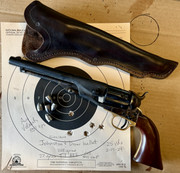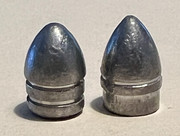 The Accurate Reloading Forums
The Accurate Reloading Forums  THE ACCURATE RELOADING.COM FORUMS
THE ACCURATE RELOADING.COM FORUMS  Other Topics
Other Topics  Black Powder
Black Powder  Civil War conicals in the 1860 Colt
Civil War conicals in the 1860 ColtGo  | New  | Find  | Notify  | Tools  | Reply  |  |
| one of us |
I had a chance to shoot a group each with the Eras Gone Johnston and Dow and the Eras Gone Kerr in my Uberti 1860 fluted-cylinder .44 this afternoon. I had hand-lubed them by rubbing an SPG clone into the lube grooves -- only one on the Johnston and Dow. The latter bullet was pretty fiddly to get into the cylinder mouth because of its longer nose, and I had to be careful to keep that nose below the mouth of each chamber. The stubby little Kerr was much easier to handle and seat. I fired the groups from 25 yards rest over my chronograph. The load consisted of 22 grains by weight of Triple 7 FFF, sparked by ancient CCI No. 11 caps given a pinch to stay on the nipples. Oddly, the Kerr, just two grains lighter than the Johnston and Dow at 226 grains, gave a higher average velocity of 826 fps than the J&D at 801 fps. But the Kerr also gave me a five-inch-plus group vs. the 2 3/4-inch group yielded by the J&D. Both groups were about 11-12 inches above the point of aim -- common in my experience with the Colt open tops. I'll shoot more groups in the near future, but at this point, it is pretty clear my Uberti prefers the Johnston and Dow over both the Kerr and the round ball. And to keep things in perspective, the J&D is virtually duplicating the muzzle velocity and speed of John Browning's .45 ACP. This was my first outing with this Uberti 1860. It is rather stiff -- perhaps the famous arbor issue -- and sucked a few caps. Kudos to Jefferson Arsenal for selling me 30 each of the J&D and Kerr for this purpose, and of course to Mark Hubbs of Eras Gone for bringing molds for these historic bullets to the market.   There is hope, even when your brain tells you there isn’t. – John Green, author | ||
|
| One of Us |
Very nice. I have fired at least a thousand rounds through various percussion revolvers since 1970, but always with round balls. Because they are easy....So it's good to see you shooting conicals; the way the revolvers were intended. | |||
|
| one of us |
Thanks Tom. I too, have shot many pounds of round balls through the 1851s, 1858s and 1860s over the years. But don't ask me to construct paper cartridges on any scale. Those things drive me nuts, although they are the pure quill historically. There is hope, even when your brain tells you there isn’t. – John Green, author | |||
|
| One of Us |
I have tried some Lee cast bullets in my Rogers and Spencer and they also went way high above point of aim. Maybe 2 ft higher than round balls at 25 yds. Any reason why this might happen? "Peace is that brief glorious moment in history when everybody stands around reloading". | |||
|
| one of us |
I can't begin to explain two feet higher! One would expect somewhat higher than with round ball given the additional weight, and I assume, significantly reduced velocity equalling more barrel time before the projectile exits. The Rogers and Spencer is an interesting revolver. There is hope, even when your brain tells you there isn’t. – John Green, author | |||
|
| One of Us |
I was attributing it to the additional recoil and slow barrel time of the conical vs. the round ball. I need to study it further. I only tried it once and since groups were off the target I didn't get much information. "Peace is that brief glorious moment in history when everybody stands around reloading". | |||
|
| One of Us |
Four reasons; 1. All revolvers of the period shoot high. I have replaced front sights on many of them. 2. Since the rear sight and front sight are not even connected by any solid piece of steel, especially if your cylinder pin is loose, when you tighten the wedge it will move the barrel upwards. 3. And also, the bore, cylinder pin, and cylinder pin hole in the barrel might not be on the same axis anyway. 4. Also, since the rear sight is the hammer, the length of the cap/fragment shield on the hammer literally determines how high your bullets will hit. Everyone forgets that. I have filed the sight notches deeper and used a fine bead sight picture which will bring the bullet impact down dramatically. Not something to worry about; install a higher front sight. All these factors make barrel time fade into irrelevance. The first cap and ball revolver I got was in 1968, a 51 Navy; first thing I did was make a rib with new front and rear sights on it and I soldered it to the barrel. Problem solved. | |||
|
| One of Us |
My Rogers and Spencer has none of these and the front sight has been replaced to shoot center with 20 grns. of FFFG and a round ball. Damn solid revolver! "Peace is that brief glorious moment in history when everybody stands around reloading". | |||
|
| One of Us |
I am sure it had situation #1 on my list. I am well aware of that period revolver designs. | |||
|
| One of Us |
Way back about 1960. Friends took me out shooting their cap n ball guns. They hit well. My shots went way high. With a bit of bitching how I was flipping it up at the shot instead of holding it still until the ball exited. Hell of a deal that cured my problem. OF course NO ONE will want to admit such things as flinching, or doing this. Just pay attention and try it. George "Gun Control is NOT about Guns' "It's about Control!!" Join the NRA today!" LM: NRA, DAV, George L. Dwight | |||
|
| One of Us |
That might have been your problem but with most flinching the shots go down. Pistols and revolvers of the period were not made for precise aiming as we do today. So sights were small and rudimentary, and were made so the bullets would always hit a standing man or one on horseback, up to 100 yards. And since any wound was 90% fatal in an era when they did not know that germs, bacteria, and infection even caused disease, any hit was a good hit. This is why all revolvers and most pistols of the pre 1870 days, shoot high. It is not an accident nor a design flaw; they are supposed to. But we 20th and 21st century shooters do not shoot at men or horses very often, at least not with a cap and ball revolver. | |||
|
one of us |
30 years ago, I had 1858 Remington replica by Pieta Italy. First I shot round balls. But later I found that best results I got was with factory lubed cast bullets for .45 ACP. Similar to those:  Bullets were soft (not HC), exactly little bit over the diameter of cylinder chambers, so every time thin perfect ring of lead occurred when seating the bullet. No other lubing necessary. Jiri | |||
|
| one of us |
I just bought Eras Gone molds for my .36 Navy and .44 Dragoon. I hope to cast bullets and try them in the next week or so. One morning I shot an elephant in my pajamas. How he got into my pajamas I'll never know. - Groucho Marx | |||
|
| one of us |
Dave, I think you will like Mark's molds. Tom, I consistently read about Uberti revolvers all having a "short arbor" problem that can contribute to shooting high. Have you ever worked to address this? There is hope, even when your brain tells you there isn’t. – John Green, author | |||
|
| Powered by Social Strata |
| Please Wait. Your request is being processed... |
|
 The Accurate Reloading Forums
The Accurate Reloading Forums  THE ACCURATE RELOADING.COM FORUMS
THE ACCURATE RELOADING.COM FORUMS  Other Topics
Other Topics  Black Powder
Black Powder  Civil War conicals in the 1860 Colt
Civil War conicals in the 1860 Colt

Visit our on-line store for AR Memorabilia

